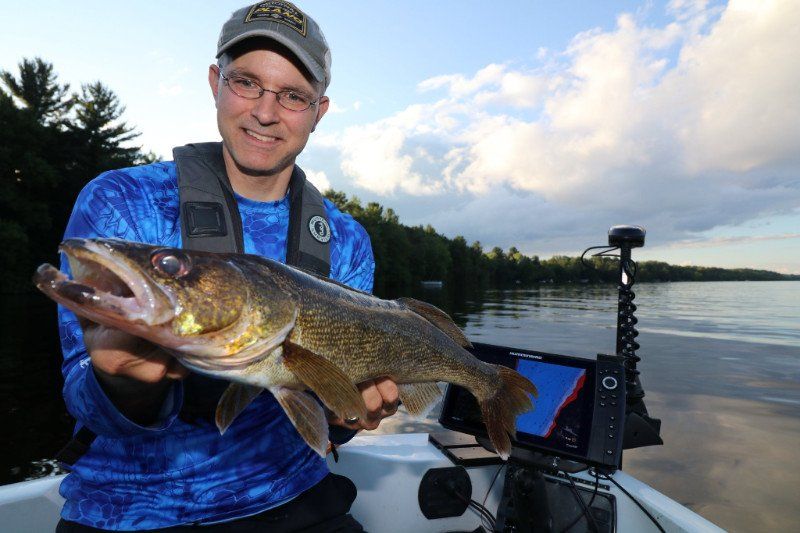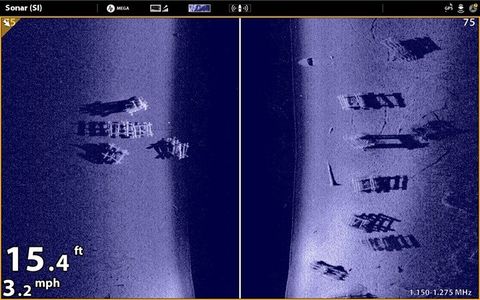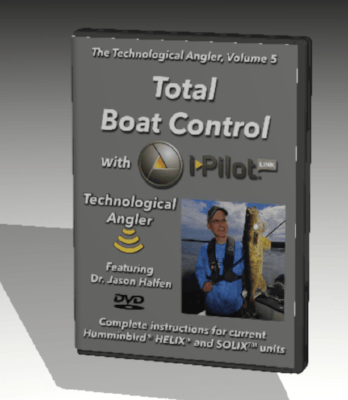
Walleyes: when to troll, and when to cast
It’s an age-old question, faced frequently by those with a penchant toward chasing walleyes: when should I troll, and when should I cast? Certainly, there is no singular “best” way to catch ol’ marble-eyes, but under many conditions, one technique – either casting or trolling – has the potential to dramatically outperform the other.
When to troll
Trolling is, by definition, a water-coverage technique, and for the purposes of this article, I’ll lump “speed trolling” techniques, like summer crankbaits, together with “finesse trolling” techniques, like live-bait rigging, under this one presentation category. During the course of any one day spent trolling, your baits will be washed through more water, and potentially be in front of more eyeballs, than during a day spent casting. But that doesn’t mean that you should troll all of the time. Here are some circumstances under which trolling truly shines.
1. Find fish on an unfamiliar body of water. First time visiting someplace new? Study the map and then break out the trolling rods. Learn as you fish – watch your fishfinder for concentrations of bait and fish, and drop waypoints whenever a rod pops. You’d be surprised how quickly you can put together a viable pattern by covering water.
2. Scattered fish over a large area. When fish are widely distributed over a significant area, whether it is a shallow flat in a lake, the deep outside bend in a river, or even suspended over a deep basin, then trolling is the best way to contact more of those fish during the course of your trip. The same rationale applies when active fish have concentrated themselves along a long, distinct breakline – whether that break is a depth change (a dropoff) or a structural element (a weedline or a rip-rap wall). Get baits behind the boat, dial up an appropriate speed with your kicker or electric trolling motor, and go.
3. Precise depth control. By virtue of the contemporary walleye-catching tools available to us, trolling offers an opportunity to enjoy more precise depth control for our baits, keeping them in the target zone longer - and more consistently - than baits presented by cast-and-retrieve cycles. Bottom bouncers and old school “Wolf River Rigs” are great for keeping spinners or small crankbaits just off the bottom. One ounce of weight for every 10 feet of water depth is what you want to shoot for. Leadcore offers flexible and predictable depth control for a wide variety of lures. One color of leadcore (10 yards) provides about five feet of depth at a speed of 2 mph, so if you want your lure to run 20 feet down, you need about 4 colors of lead in the water. Flatline trollers use published dive curves for crankbaits to select just the right bait, deployed on the correct amount of line, to hit a target depth. This level of precise depth control is not really accessible to the angler casting and retrieving, unless their target depth is “the bottom” – then, a jig and bait, or a jigging rap, will out them where they want to be.
4. Multiple line presentations. In states where anglers are allowed to use multiple lines at once, trolling is one the best ways to manage them. For example, an angler presenting two lures can troll one near the bottom with leadcore, and a second higher in the water column by flatline trolling a shallow diver – now, we’ve covering two different depths at the same time, while minimizing the risk of tangles. Two anglers running four lines? Two leadcore lines off the back corners, and two flatlines or planar board lines. More anglers or lines than that? Break out the boards and trolling trees. Good luck managing all of those lures, and dealing with fish, tangles, and snags if everyone is casting instead.
When to troll
Trolling is, by definition, a water-coverage technique, and for the purposes of this article, I’ll lump “speed trolling” techniques, like summer crankbaits, together with “finesse trolling” techniques, like live-bait rigging, under this one presentation category. During the course of any one day spent trolling, your baits will be washed through more water, and potentially be in front of more eyeballs, than during a day spent casting. But that doesn’t mean that you should troll all of the time. Here are some circumstances under which trolling truly shines.
1. Find fish on an unfamiliar body of water. First time visiting someplace new? Study the map and then break out the trolling rods. Learn as you fish – watch your fishfinder for concentrations of bait and fish, and drop waypoints whenever a rod pops. You’d be surprised how quickly you can put together a viable pattern by covering water.
2. Scattered fish over a large area. When fish are widely distributed over a significant area, whether it is a shallow flat in a lake, the deep outside bend in a river, or even suspended over a deep basin, then trolling is the best way to contact more of those fish during the course of your trip. The same rationale applies when active fish have concentrated themselves along a long, distinct breakline – whether that break is a depth change (a dropoff) or a structural element (a weedline or a rip-rap wall). Get baits behind the boat, dial up an appropriate speed with your kicker or electric trolling motor, and go.
3. Precise depth control. By virtue of the contemporary walleye-catching tools available to us, trolling offers an opportunity to enjoy more precise depth control for our baits, keeping them in the target zone longer - and more consistently - than baits presented by cast-and-retrieve cycles. Bottom bouncers and old school “Wolf River Rigs” are great for keeping spinners or small crankbaits just off the bottom. One ounce of weight for every 10 feet of water depth is what you want to shoot for. Leadcore offers flexible and predictable depth control for a wide variety of lures. One color of leadcore (10 yards) provides about five feet of depth at a speed of 2 mph, so if you want your lure to run 20 feet down, you need about 4 colors of lead in the water. Flatline trollers use published dive curves for crankbaits to select just the right bait, deployed on the correct amount of line, to hit a target depth. This level of precise depth control is not really accessible to the angler casting and retrieving, unless their target depth is “the bottom” – then, a jig and bait, or a jigging rap, will out them where they want to be.
4. Multiple line presentations. In states where anglers are allowed to use multiple lines at once, trolling is one the best ways to manage them. For example, an angler presenting two lures can troll one near the bottom with leadcore, and a second higher in the water column by flatline trolling a shallow diver – now, we’ve covering two different depths at the same time, while minimizing the risk of tangles. Two anglers running four lines? Two leadcore lines off the back corners, and two flatlines or planar board lines. More anglers or lines than that? Break out the boards and trolling trees. Good luck managing all of those lures, and dealing with fish, tangles, and snags if everyone is casting instead.
Angler's Guide to Sonar Interpretation
We offer unique, on-the-water perspectives to teach you how to interpret Side Imaging, Down Imaging, and traditional 2D sonar. Each lesson is supported by numerous, interpreted screen captures from lakes, rivers and reservoirs, many of which are supported by underwater video from Aqua-Vu cameras. With help from The Technological Angler, you will learn to interpret all of the information that your fish finder provides, so you can have more fun on the water and enjoy more productive trips. Let the learning begin!
We offer unique, on-the-water perspectives to teach you how to interpret Side Imaging, Down Imaging, and traditional 2D sonar. Each lesson is supported by numerous, interpreted screen captures from lakes, rivers and reservoirs, many of which are supported by underwater video from Aqua-Vu cameras. With help from The Technological Angler, you will learn to interpret all of the information that your fish finder provides, so you can have more fun on the water and enjoy more productive trips. Let the learning begin!
When to cast
Casting is generally a slower, more methodical, “saturation” technique. You might encounter more fish by trolling, simply based on miles of water covered, but you may trigger more bites while working over pods of fish by casting. Here are some circumstances when casting may be the right choice for you.
1. Fish concentrated in specific places. Anytime that active fish are located on a specific piece of cover, like a mid-lake rock bar, a weed point, a wing dam in a river or a shallow bay with an inlet, casting to those fish is frequently the best way to target them. Frequently, you could troll through those same spots - but when you consider the time spent setting up before the “hot spot” and then getting reorganized for another pass through it – positioning the boat by anchoring or Spot Locking and then saturating the target with baits presented by casting is far more efficient. More time with baits in front of active fish will generally mean more fish in the net by the end of the day.
2. Mixed presentations. I think about this as another pattern-development tool. When you want to show a group of fish a variety of presentations all at once, then positioning the boat and casting to them is the way to go. Somebody can soak a leech under a bobber, somebody can snap-jig a soft plastic, and someone else can cast a crank. If you have a reasonable idea about where the fish are (or where they should be), then showing them a bunch of different options can help establish a pattern that carries you through several hours or even an entire trip.
3. Finesse when it’s needed. If trolling is a power-fishing technique, then casting gives us the opportunity to slow down and finesse finicky fish. That might mean casting a Ned Rig or a jig-and-leech, slowly working a live bait rig through a group of boulders, or drifting slip bobbers through a stumpfield. When “slow” is the word of the day, then casting to fish (and sipping a cup of decaf) can be the best way to catch them.
Casting is generally a slower, more methodical, “saturation” technique. You might encounter more fish by trolling, simply based on miles of water covered, but you may trigger more bites while working over pods of fish by casting. Here are some circumstances when casting may be the right choice for you.
1. Fish concentrated in specific places. Anytime that active fish are located on a specific piece of cover, like a mid-lake rock bar, a weed point, a wing dam in a river or a shallow bay with an inlet, casting to those fish is frequently the best way to target them. Frequently, you could troll through those same spots - but when you consider the time spent setting up before the “hot spot” and then getting reorganized for another pass through it – positioning the boat by anchoring or Spot Locking and then saturating the target with baits presented by casting is far more efficient. More time with baits in front of active fish will generally mean more fish in the net by the end of the day.
2. Mixed presentations. I think about this as another pattern-development tool. When you want to show a group of fish a variety of presentations all at once, then positioning the boat and casting to them is the way to go. Somebody can soak a leech under a bobber, somebody can snap-jig a soft plastic, and someone else can cast a crank. If you have a reasonable idea about where the fish are (or where they should be), then showing them a bunch of different options can help establish a pattern that carries you through several hours or even an entire trip.
3. Finesse when it’s needed. If trolling is a power-fishing technique, then casting gives us the opportunity to slow down and finesse finicky fish. That might mean casting a Ned Rig or a jig-and-leech, slowly working a live bait rig through a group of boulders, or drifting slip bobbers through a stumpfield. When “slow” is the word of the day, then casting to fish (and sipping a cup of decaf) can be the best way to catch them.
Unleash the power of i-Pilot Link, so you can find and catch more fish, with this complete i-Pilot Link instructional DVD. Filmed entirely on the water, Total Boat Control with i-Pilot Link provides comprehensive instruction for the Minn Kota i-Pilot Link system, interfaced with Humminbird HELIX and SOLIX fish finders. Instructional details are provided for each of i-Pilot Link's 10 core features and functions, with input coming from the fish finder, from the remote, and from the foot pedal. This is the best, most complete, i-Pilot Link reference work available!

